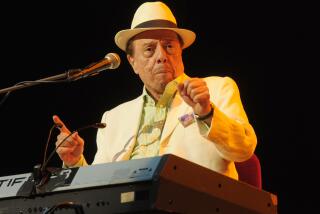JAZZ REVIEW : Ariel’s Compositions Bring Out Best in Brazilian Beat
- Share via
COSTA MESA — The most attractive thing about Rio de Janeiro native Marcos Ariel’s performances are his compositions. Not content like so many others to rehash the popular music of his countrymen, or jazz standards that cop Brazilian beats, this keyboard player has created his own hybrid, one that spans jazz, samba and bossa nova, all backed with strong rhythms.
His first set Saturday at Mucho Gusto was a fine, six-tune showcase of his writing. Working with bassist Keith Jones, saxophonist Gary Meek and drummer Michael Shapiro, Ariel showed a taste for strong melodies, varying rhythmic formats and sharply exclaimed endings. His lush, electric piano tones played directly to the beat of a tune, and his solos were filled with strong jazz influences.
Instead of just riffing, Ariel and company worked a variety of tempo formats into almost every number. “Seven O’Clock Train” started out at a moderate pace before picking up steam during Meek’s agile tenor solo. The group then broke into a determined jazz walk until bassman Jones worked up a solo decorated with guitar-like chordal play. The song returned to its original pace before chugging to a close.
Meek, a longtime member of Airto Moreira and Flora Purim’s ensemble, showed some Stan Getz cool during Ariel’s “Bridge To Love.” The composer entered his own improvisation with deliberately stated phrases set against Shapiro’s beat before expanding his statement in speed and complexity. Shapiro has a knack for mixing up his attack, peppering his play with rim hits and tom-tom exchanges. He was especially inventive with shuffling beats, running through them at a gallop.
Ariel and Meek, without bass and only a minimum of spare, hand-played percussion, teamed for the ballad “Calma,” and the tranquil melody line seemed to float suspended over the pianist’s chordal backing. Meek’s soprano meandered easily through this framework, becoming more ambitious with each phrase. Ariel could not help but move into the familiar, two-beat Latin rhythm during his solo, before swirling back to less defined rhythmic territory.
Though Ariel’s strengths as a keyboardist seem to come across better on acoustic piano (he played only electric here), he continually turned his solos into a series of dance figures that leaped and pirouetted across Jones’ light-footed bass playing. Ariel was especially expansive in “Manaus,” matching be-bop-flavored runs with octave jumps and touches of dissonance.
This quartet has worked together for a while now, and it shows in the tightness of the ensemble play. Rather than just trickling off into silence as so many bands do when playing sambas, the musicians gave most of the tunes sharply defined endings, each with a touch of drama. The tight, three-tone close of “Manaus” was particularly emphatic as Meeks’ soprano pin-pointed each note with laser-like clarity.
More to Read
The biggest entertainment stories
Get our big stories about Hollywood, film, television, music, arts, culture and more right in your inbox as soon as they publish.
You may occasionally receive promotional content from the Los Angeles Times.










